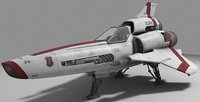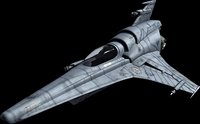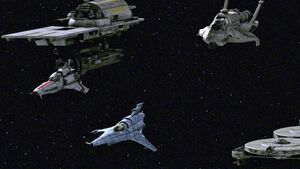Viper (TRS): Difference between revisions
More languages
More actions
→Atmospheric Operations: elaborating |
→Flight Regimes: reordering to correspond to rest of section |
||
| Line 11: | Line 11: | ||
[[Image:Mk VII with Mk II, patrol.jpg|thumb|right|A Viper Mk. II and a Mk. VII on patrol ([[33]]).]] | [[Image:Mk VII with Mk II, patrol.jpg|thumb|right|A Viper Mk. II and a Mk. VII on patrol ([[33]]).]] | ||
The Viper is designed to operate in both atmospheric | The Viper is designed to operate in both space and atmospheric conditions. | ||
In space flight, the Viper is highly maneuverable, dangerously so in inexperienced hands. [[Navigation in the Re-imagined Series|Reaction control system]] (RCS) thrusters for rapid and flexible attitude control, a cluster of 3 main thrusters for high acceleration, and retractable reverse thrusters housed in both port and starboard cowlings for some degree of deceleration can subject the pilot to punishing g-forces. Its retractable landing struts can be magnetized to secure the Viper on metal decks and surfaces in zero gravity. | In space flight, the Viper is highly maneuverable, dangerously so in inexperienced hands. [[Navigation in the Re-imagined Series|Reaction control system]] (RCS) thrusters for rapid and flexible attitude control, a cluster of 3 main thrusters for high acceleration, and retractable reverse thrusters housed in both port and starboard cowlings for some degree of deceleration can subject the pilot to punishing g-forces. Its retractable landing struts can be magnetized to secure the Viper on metal decks and surfaces in zero gravity. | ||
Revision as of 06:19, 28 March 2008
- This is an overview page on the subject of Viper fighter craft. For detailed information, see the sections listed in the sidebar to your left.
The Viper is the Colonial Fleet's primary space superiority fighter / attack craft.


The Viper Mk II was originally introduced into Colonial service shortly before the outbreak of the Cylon War where it served with distinction throughout the war. It was subsequently retired and replaced with newer models. By the time of the renewed Cylon attack on the Twelve Colonies, the Mark VII was the standard front-line model.
Flight Regimes

The Viper is designed to operate in both space and atmospheric conditions.
In space flight, the Viper is highly maneuverable, dangerously so in inexperienced hands. Reaction control system (RCS) thrusters for rapid and flexible attitude control, a cluster of 3 main thrusters for high acceleration, and retractable reverse thrusters housed in both port and starboard cowlings for some degree of deceleration can subject the pilot to punishing g-forces. Its retractable landing struts can be magnetized to secure the Viper on metal decks and surfaces in zero gravity.
In atmospheric flight, Vipers consume more fuel than in the vacuum of space. Once in an atmosphere, the engines must run continuously to maintain sufficient airflow over the wing lifting surfaces. Depending on the composition of the atmosphere itself, this can place severe strain on the Viper's engines (You Can't Go Home Again). In addition to greater fuel consumption, the high wing load (i.e. small wing area relative to weight) may compromise the Viper's overall maneuverability. Because the smaller wing surfaces generate less lift, higher speeds are needed to stay aloft. The fighter's RCS thrusters might partially compensate for this.
Life Support
Viper cockpits are pressurized and heated, but the pilot wears a flight suit that provides full life support should ejection be required (You Can't Go Home Again). A life support backpack is built into the pilot's seat itself. During an ejection, the back of the seat separates automatically, effectively becoming a backpack for the pilot using the seat's harnesses as straps (Act of Contrition). Should ejection take place within an atmosphere, the life support backpack also incorporates a parachute.
Because the life support systems do not include artificial gravity, inertial dampeners, or the like, pilots are fully exposed to the effects of acceleration. To prepare for the strains this causes on the body, battlestars have a specialized weight room.
<pagesidebar>
- See Also
- Viper Mark II|Mark II Viper
- Viper Mark VII|Mark VII Viper
- Other Series
- Viper (TOS)|Original Series Viper
- Viper (1980)|Galactica 1980 Viper
</pagesidebar>
